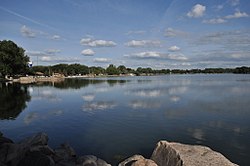Demographics
2020 census
As of the census of 2020, [8] there were 1,113 people, 549 households, and 312 families residing in the city. The population density was 535.6 inhabitants per square mile (206.8/km2). There were 868 housing units at an average density of 417.7 per square mile (161.3/km2). The racial makeup of the city was 97.8% White, 0.1% Black or African American, 0.0% Native American, 0.0% Asian, 0.1% Pacific Islander, 0.4% from other races and 1.6% from two or more races. Hispanic or Latino persons of any race comprised 1.4% of the population.
Of the 549 households, 15.3% of which had children under the age of 18 living with them, 47.5% were married couples living together, 6.7% were cohabitating couples, 28.6% had a female householder with no spouse or partner present and 17.1% had a male householder with no spouse or partner present. 43.2% of all households were non-families. 36.6% of all households were made up of individuals, 22.2% had someone living alone who was 65 years old or older.
The median age in the city was 58.9 years. 15.8% of the residents were under the age of 20; 3.1% were between the ages of 20 and 24; 15.2% were from 25 and 44; 29.3% were from 45 and 64; and 36.7% were 65 years of age or older. The gender makeup of the city was 46.5% male and 53.5% female.
2010 census
As of the census [9] of 2010, there were 1,142 people, 564 households, and 326 families residing in the city. The population density was 538.7 inhabitants per square mile (208.0/km2). There were 950 housing units at an average density of 448.1 per square mile (173.0/km2). The racial makeup of the city was 99.3% White, 0.3% African American, 0.1% Pacific Islander, and 0.4% from two or more races. Hispanic or Latino of any race were 0.1% of the population.
There were 564 households, of which 17.7% had children under the age of 18 living with them, 48.2% were married couples living together, 6.2% had a female householder with no husband present, 3.4% had a male householder with no wife present, and 42.2% were non-families. 38.8% of all households were made up of individuals, and 20.9% had someone living alone who was 65 years of age or older. The average household size was 1.95 and the average family size was 2.54.
The median age in the city was 54.3 years. 16.1% of residents were under the age of 18; 3.5% were between the ages of 18 and 24; 16.7% were from 25 to 44; 33.3% were from 45 to 64; and 30.5% were 65 years of age or older. The gender makeup of the city was 47.2% male and 52.8% female.
2000 census
As of the census [10] of 2000, there were 1,278 people, 571 households, and 360 families residing in the city. The population density was 696.4 inhabitants per square mile (268.9/km2). There were 818 housing units at an average density of 445.8 per square mile (172.1/km2). The racial makeup of the city was 99.06% White, 0.39% African American, 0.08% Native American, and 0.47% from two or more races. Hispanic or Latino of any race were 0.23% of the population.
There were 571 households, out of which 22.9% had children under the age of 18 living with them, 54.6% were married couples living together, 7.4% had a female householder with no husband present, and 36.8% were non-families. 33.1% of all households were made up of individuals, and 19.1% had someone living alone who was 65 years of age or older. The average household size was 2.18 and the average family size was 2.75.
In the city, the population was spread out, with 20.7% under the age of 18, 4.4% from 18 to 24, 19.7% from 25 to 44, 26.5% from 45 to 64, and 28.7% who were 65 years of age or older. The median age was 48 years. For every 100 females, there were 87.9 males. For every 100 females age 18 and over, there were 81.1 males.
The median income for a household in the city was $26,691, and the median income for a family was $33,333. Males had a median income of $26,932 versus $19,773 for females. The per capita income for the city was $15,857. About 9.5% of families and 13.3% of the population were below the poverty line, including 24.0% of those under age 18 and 8.5% of those age 65 or over.
Education
The city is served by the East Sac County Community School District. [12] It was a part of the Lake View-Auburn Community School District until July 1, 1996, when it merged into the Wall Lake View Auburn School District. That in turn merged into East Sac County on July 1, 2011. [13]
Lake View has one school, the high school for the district. The elementary school is located in Sac City, and the middle school is also in Sac City. It was formerly the combined high school and middle school for the Wall Lake View Auburn School District. The school's mascot is a Viking-inspired "Raider". The superintendent is Jeff Kruse. The principal of the high school is Kevin Litterer.
This page is based on this
Wikipedia article Text is available under the
CC BY-SA 4.0 license; additional terms may apply.
Images, videos and audio are available under their respective licenses.


